Technology
Snail Dough Maker
Thankfully it's for making dough to wrap snails in, rather than making dough out of snails.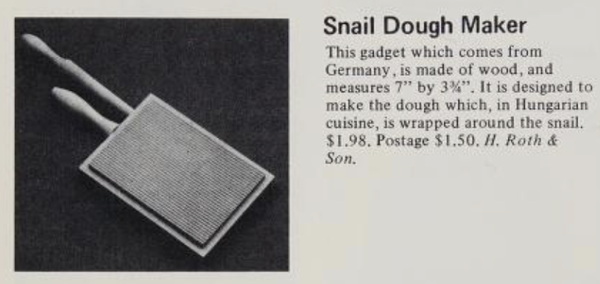
source: Catalog of the Unusual (1973), by Harold H. Hart
Posted By: Alex - Sat Mar 16, 2024 -
Comments (1)
Category: Food, Technology
1963 Prediction of Mobile Phones
In 1963 the Mansfield News-Journal predicted that, "Some day, Mansfielders will carry their telephones in their pockets."So when did the first phone debut that could be carried in a pocket? Depends on the size of the pocket, I guess. But I think it was arguably the Motorola StarTAC, that came out in 1996 — 33 years after the News-Journal prediction.

Mansfield News-Journal - Apr 18, 1963
Posted By: Alex - Fri Mar 15, 2024 -
Comments (4)
Category: Technology, Telephones, Yesterday’s Tomorrows
Mystery Gadget 109
What's it for?The answer is here.
Or after the jump.
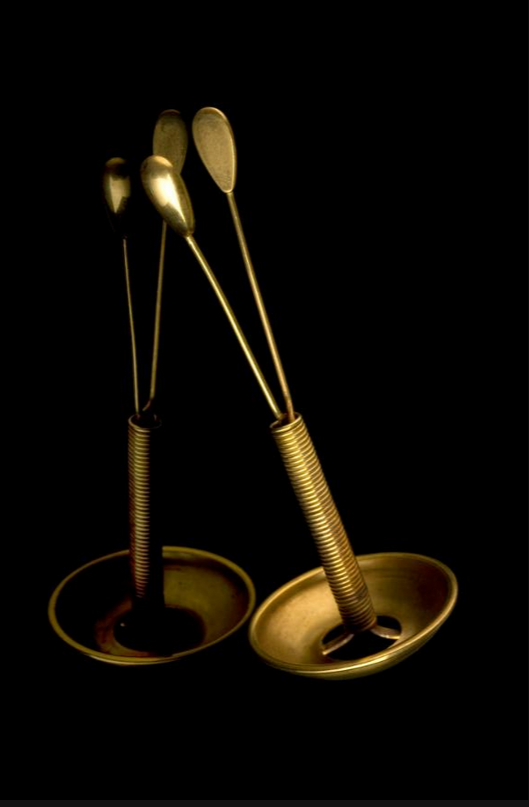
More in extended >>
Posted By: Paul - Thu Mar 07, 2024 -
Comments (3)
Category: Technology, Nineteenth Century
The Sony SmartWig
Sony was granted a patent for its "SmartWig" in 2016, but, to date, it doesn't seem to have brought the device to market.The idea was that a person could pair their smartphone with the wig and then receive "tactile feedback" (such as a vibration) when they received a text or email.
But that was just the tip of the iceberg. The SmartWig had many more potential uses, such as the following:
I imagine it would be a lot more difficult to aim a laser pointer with your head rather than your hand. Not to mention it would look bizarre.


#40 represents the possible location of a laser pointer
Posted By: Alex - Sat Feb 24, 2024 -
Comments (1)
Category: Technology, Patents, Hair and Hairstyling
The Avrocar Military Flying Saucer
If only this project had succeeded, we'd all have Jetson-style flying saucers today!Here is the Wikipedia page.
But I do think the version patented by one C. P. Lent right around the same time has a classier shape.
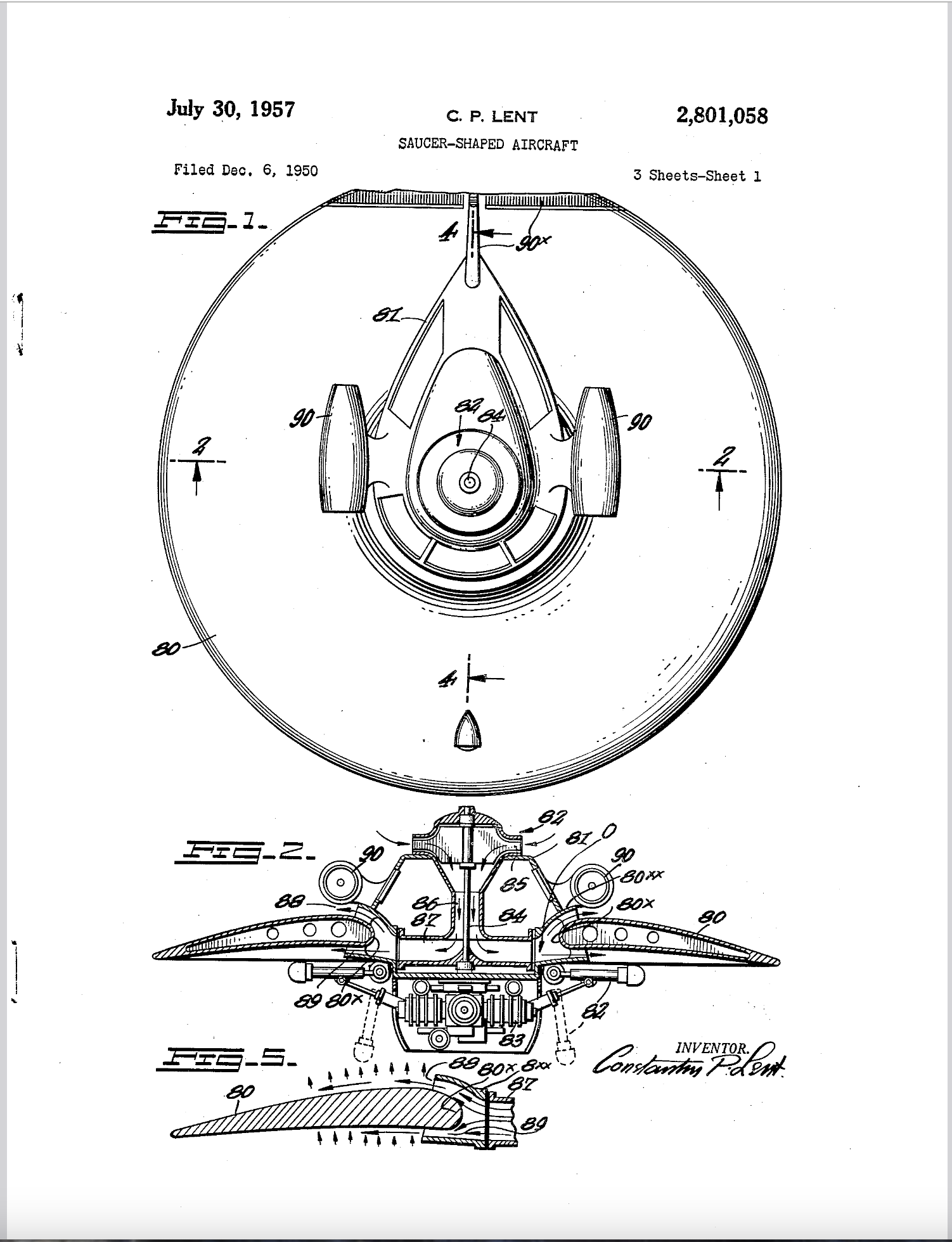
Posted By: Paul - Thu Jan 25, 2024 -
Comments (1)
Category: Flight, Military, Technology, Patents, 1950s
Mushroom-Based Air Conditioning
Researchers at Johns Hopkins have invented (and patented) a mushroom-powered air cooling system that can reduce the temperature in a semiclosed compartment by approximately 10 °C in 25 minutes. They call it the "MycoCooler." From their recent article in PNAS:It's an interesting concept, but somehow I don't think a MycoCooler would be powerful enough to beat the heat here in Arizona. (Though in the days before AC, everyone here used evaporative coolers. But they also say that it's much hotter here than it used to be... a combination of global warming and the urban heat-island effect.)
More info: Johns Hopkins, Patent No. 11871707

Posted By: Alex - Tue Jan 23, 2024 -
Comments (2)
Category: Technology, Patents
Sheaffer Pen accurately predicted the future
In 1963 and 1964, Sheaffer Pen ran an ad campaign in which they made a variety of predictions about future technologies of the 21st century. The company contrasted these technologies, which must have seemed a bit pie-in-the-sky at the time, with the timeless performance of a Sheaffer pen. The surprising thing is that all their predictions have come true: instant mail delivery, checkbooks that balance themselves electronically, portable visual phones, ring tape recorders, camera sunglasses, credit card rings, electronic translators.They don't all exist in the specific form that Sheaffer imagined (credit card rings?), but in each case the equivalent or better exists.





Newsweek - Sep 23, 1963
Posted By: Alex - Sun Jan 21, 2024 -
Comments (4)
Category: Technology, Advertising, 1960s, Yesterday’s Tomorrows
Mystery Gadget 108
This is not an iron lung machine. So then, what's going on?The answer is here.
Or after the jump.
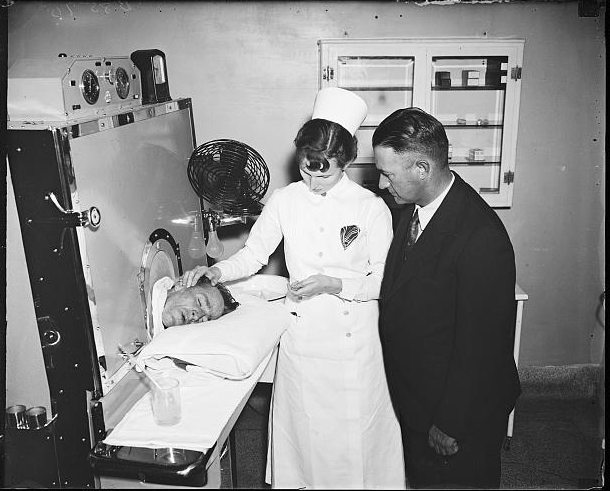
More in extended >>
Posted By: Paul - Thu Jan 18, 2024 -
Comments (4)
Category: Technology, Twentieth Century
Pocket Typewriter
In 1952, Maurice Julliard patented a typewriter small enough to fit inside "an average size pocket." It could be used "without any support, being simply held in the hand."His patent included a sketch of the typewriter, but I haven't been able to find any pictures of it. I'm not sure what practical use it was supposed to have, beyond being a novelty. His patent doesn't say. Would one use it to type miniature notes or manuscripts?
I noticed that it had a non-qwerty keyboard.

The Hackensack Record - July 24, 1952

Julliard's pocket typewriter wasn't the first one in existence. The book Victorian Inventions by Leonard de Vries contains an example from 1891. Though unlike Julliard's typewriter, it lacked a keyboard.
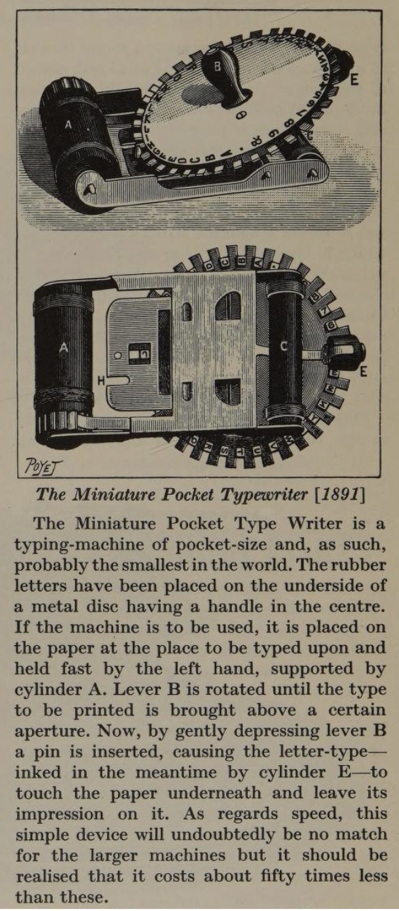
Posted By: Alex - Sun Jan 07, 2024 -
Comments (2)
Category: Technology, Patents, 1950s
301 views
The video below is interesting as a peek into the way that YouTube works, but it's also interesting as a YouTube curiosity because its view counter is permanently stuck at 301, and has been for 11 years now, even though its actual view count is probably well over 1 million. Someone at YouTube had to deliberately freeze its view counter. As far as I know, it's the only video on YouTube that's received special treatment in this way.
Posted By: Alex - Fri Dec 08, 2023 -
Comments (1)
Category: Technology, Internet, Video

| Who We Are |
|---|
| Alex Boese Alex is the creator and curator of the Museum of Hoaxes. He's also the author of various weird, non-fiction, science-themed books such as Elephants on Acid and Psychedelic Apes. Paul Di Filippo Paul has been paid to put weird ideas into fictional form for over thirty years, in his career as a noted science fiction writer. He has recently begun blogging on many curious topics with three fellow writers at The Inferior 4+1. Contact Us |




